ISSN ONLINE(2278-8875) PRINT (2320-3765)
ISSN ONLINE(2278-8875) PRINT (2320-3765)
Vidya.S1 and Manju Rani2
|
| Related article at Pubmed, Scholar Google |
Visit for more related articles at International Journal of Advanced Research in Electrical, Electronics and Instrumentation Engineering
Inter-symbol-interference (ISI) has become one of the major obstacle in achieving high speed and high capacity wireless communication. In this paper, we propose a time reversal transmission method which converges energy both in spatial and temporal domains and thereby reduces ISI. The system performances of multiple transmit antenna schemes using Time Reversal Division Multiple Access (TRDMA) is evaluated in terms of effective signal-tointerference- plus-noise-ratio and achievable sum rate .Also the bit error rate of TRDMA over Code division Multiple Access and the impact of modulation schemes on effective SINR is investigated. Simulation results obtained using multiuser downlink systems makes it a high speed wireless transmission method in the future.
Keywords |
| Time reversal, TRDMA, temporal focussing, spatial focusing |
INTRODUCTION |
| Severe ISI in a rich scattering environment makes high speed broadband communication a very challenging task. Though it can be resolved using OFDM or complex equalization methods it often increases the complexity of end user equipments in many applications. One of the important ability of a communication system is to exploit independent channels of propagation while data is sent through a disordered medium, the more scattering the medium is, the more is the degrees of freedom to communicate through it. In the case of radio signals, multiple paths arise because of scattering and multiple reverberations on the buildings or indoors and time reversal signal transmission exploits the multipath propagation and thereby provide a great potential of low-complexity energy efficient communications. Time reversal signal processing is used for focussing waves in which a signal is first radiated through a rich scattering medium. The signal which is scattered back is then recorded, time reversed, and retransmitted. The history of time reversal technology dates from the early 1990’s.The TR technology was used first in the optical domains and then in underwater propagation environments. It was later validated in Ultra-Wideband systems. Further it was verified as an ideal paradigm for green wireless communication. A green wireless technology ensures low energy consumption and low radio pollution to others than the intended user.L88ater it was tested and verified in UWB systems [9]-[12]. |
| The time reversal technique is based on channel reciprocity.The single user wireless communications consist of two phases: recording phase and transmission phase. If transceiver A wants to transmit information to transceiver B, an impulse is sent by transceiver B which propagates through a scattering multi-path environment and the signals are received and then recorded by the time reversal mirrors of transceiver A. Transceiver A transmits the time-reversed and conjugated waves back through the communication link to transceiver B. The TR waves retraces the incoming paths by using channel reciprocity and ends up in a “spiky” signal-power spatial distribution focused only at the intended receiver, which is referred to as spatial focusing effect [5] [12].Time reversal technology uses multipath channel as a matched filter computing machine for the meant receiver and thus concentrates energy in the time domain also, referred to as temporal focussing effect. Because of temporal focussing effect, received power is concentrated within few taps and equalizer design tasks simpler. Sharpened matched filter response will reduce ISI if length of multipath pulse train is large and thus utilizes the rich multipath instead of treating it as nuisance. |
| Time reversal technique achieves a high diversity gain and high-resolution “pin-point” spatial focusing effect which maps the multi-path propagation profiles into unique and independent location-specific signatures in the multipath environment. The concept of TRDMA proposed in this paper is supported by several important recent works [14]–[16]. |
| Solid simulation results concerning bit-error-ratio (BER) clearly shows the feasibility of applying TR to data streams that are spatially multiplexed. In a complex environment signal received will have undergone many multiple reflections, scattering and refractions. Received signal will be the sum of multiple attenuated and also time delayed versions of the original signal. When the received signal is time-reversed and retransmitted, the time-delayed components radiate through the same channel and converge on the original location of the source. This convergence occurs both in space and time. In this paper Time-Reversal structure is used in multi-user downlink system over multipath Rayleigh fading channel, where signals of multiple users are separated by TRDMA and evaluate a number of performance metrics such as achievable sum rate and effective SINR. We also further investigate the bit error rate improvement over CDMA and the impact of modulation schemes, BPSK and BFSK in effective SINR. |
CHANNEL MODEL |
| A. System Model |
| We consider multi-user downlink network over multipath Rayleigh fading channels. First, we look at the SISO case in which users and base station (BS) transmit using single antenna. The channel impulse response (CIR) of the communication link between the BS and the i-th user is modelled as |
 |
| where hi[k] is the k-th tap of the CIR with length L, and δ[·] is the Dirac delta function. It is assumed that the CIRs of different users are uncorrelated. This assumption can very much simplify the analysis, even though CIRs might not be perfectly uncorrelated while capturing idea of TRDMA.Real-life experimental results in [5], [12] showed that when two locations are just several wavelengths apart the correlation between CIRs associated with different locations decreases to a level which is neglectable.Each duty cycle has transmission phase and recording phase which occupy (1 − n ) and n of the cycle period with value of n between 0 and 1. |
| B. Recording Phase |
| In the recording phase, by taking turns the N users transmit an impulse signal to the BS (ideally it can be a Dirac δ−function). At the BS, Time-Reversal Mirrors (TRMs) record the channel response of each link and store the timereversed and conjugated form for the transmission phase. In our analysis we assume that the waveform recorded by TRMs at the transmission side reflects the true CIR, Fig.1 shows the block diagram of SISO TRDMA multiuser downlink system. TRMs shown in the block diagram can be arrays of transducers which are used to focus the signal. At first, TRM transmits a plane wave which travels through the channel towards the intended user and is reflected back. The reflected waveform returns to the TRM, where it looks as if the user has emitted a (weak) signal. The signal is reversed and retransmitted by TRM and a more focused wave travels toward the target or the intended user. |
| C. Transmission Phase |
| The system starts the transmission phase after the recording phase. Each of the data represents a sequence of information symbols which are independent complex random variables with mean 0.The input sequences are up sampled by a factor D which is the ratio of sampling rate to baud rate and is expressed as |
 |
| The sequences are then fed to the TRMs and the output of the i-th TRM is the convolution of i-th up sampled sequence and the TR waveform, gi .then, all outputs are summed together and the combined signal is transmitted through the wireless channels with |
 |
 |
| The average total transmit power at the base station, P is |
 |
| At user i the signal received can be expressed as, |
 |
| where ni[k] is additive white Gaussian noise with zero mean and variance σ2.At the i-th receiver the received signal is deconvoluted and down sampled with D ending up in Yi[k]. |
| D. TRDMA with Multiple Transmit Antennas |
| In order to maintain low complexity at receiver side, we consider a MISO case where the BS at the transmission side is equipped with MT antennas together with multiple single-antenna users. Let hi (m)[k] denote the k-th tap of the CIR for the communication link between user i and the m-th antenna of the BS.We also assume that uncorrelated paths are associated with the different antennas. Each antenna at the BS in the MISO TRDMA scheme and the single antenna BS plays similar role. The block diagram for the MISO TRDMA is shown in Fig. 2. |
| In the following sections we evaluate a number of system performances such as the bit error rate, the achievable sum rate; the outage probability and the effective SINR.We also evaluate the bit error rate improvement of the proposed system over CDMA. |
 |
EFFECTIVE SINR |
| The effective SINR of the proposed system is evaluated in the section.Yi[k] received can the categorized into signal, inter-symbol interference (ISI), noise and inter-user interference (IUI). We can calculate the signal power as Psig(i ) as |
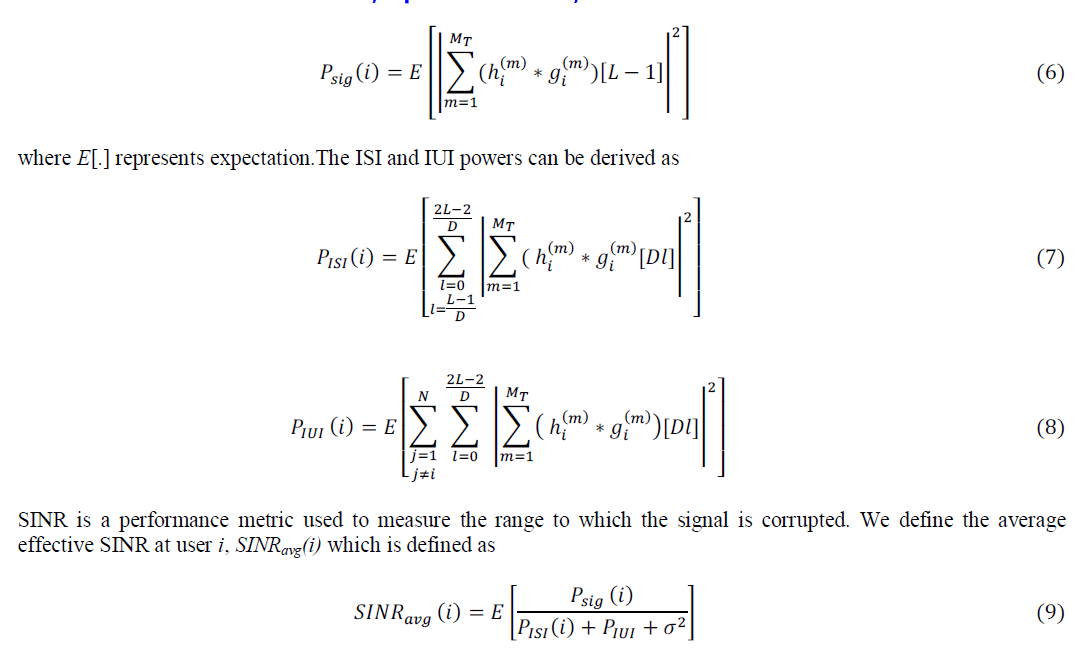 |
| Next we evaluate the average effective SINR versus ρ (signal to noise ratio) in terms of N (the number of users) MT (the number of antennas).Fig. 3 is plotted with D = 2 and N = 5, demonstrating the impact of MT to the effective SINR. From eqn.(6)-(8),one can see that average interference powers(ISI and IUI) do not depend on MT, whereas power level of the signal increases with MT.This is due to the enhanced focusing effect obtained with the use of multiple transmit antennas . |
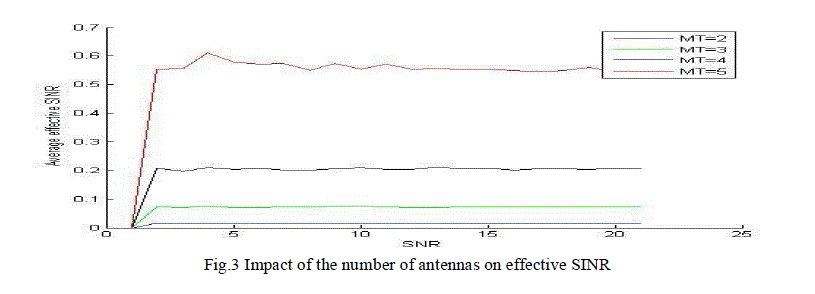 |
ACHIEVABLE RATE |
| In this section, we evaluate the average achievable sum rate and outage probability for the TRDMA multi-user network. The achievable sum rate is an important metric of the efficiency of a wireless downlink scheme. The achievable sum rate measures the total amount of information which can be delivered effectively within a power constraint P. |
| The average achievable sum rate is a good reference of the long-term performance which can be calculated by |
 (10) (10) |
| Without loss of generality, we use η ≈ 1, ignoring the overhead caused by recording phase in each duty cycle, which is valid when the fading channels are not varying fast. Fig.4. plots the average achievable sum rate with different transmit antennas with D=2 and N=4. From fig.4 one can see that the sum rate increases with the number of antennas. From eqn.(4)-(6),one can see that average interference powers(ISI and IUI) do not depend on MT, whereas power level of the signal increases with MT.This is due to the enhanced focusing effect with the use of multiple transmit antennas leveraging the multipaths.This focusing effect helps in improving the average effective SINR. |
BIT ERROR RATE OF TRDMA OVER CDMA |
| In this part, we investigate TRDMA’s improvement of bit error rate over CDMA by taking benefit of the high resolution spatial focussing effect. If large amount of errors occur when data is sent through the data link, integrity of the system might have to be compromised. Hence, it’s important to access the performance of a system and BER provides an ideal way in which this can be achieved. Bit error rate is calculated the total number of bit errors in the amount of bits sent. Here, Rayleigh channel model is considered. System model is same as that of the MISO scheme. |
| CDMA is one of the basic technologies used in mobile phones. It’s another multiple access method which allows several users to communicate over a single channel. To undue interference between users CDMA employs a special coding scheme where each user is assigned a code. Here, we spread the sequences using Walsh codes. These codes are mutually orthogonal. Hadamard matrices can be used to generate Walsh codes of orders with power of 2.The rows of the matrix of order 2n constitutes the Walsh codes which encodes N bit sequences. |
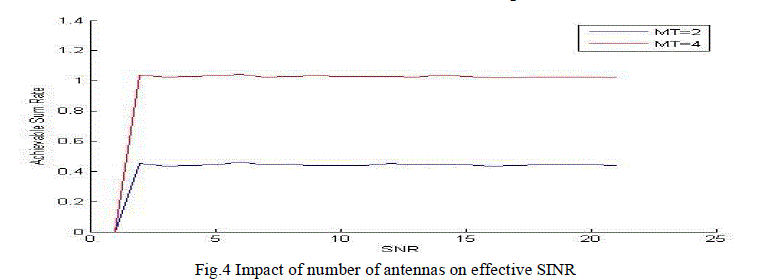 |
| Before transmission we append cyclic prefix for each user. The receiver discards the cyclic prefix samples. The cyclic prefix tends to eliminate inter-symbol interference from previous symbols. Also this approach allows simple frequency domain processing such as channel estimation and equalization. The user signals are then combined and transmitted through the wireless channel.Fig.5 shows the plot of bit error rate of TRDMA and fig.6 shows the bit error improvement over CDMA.Bit error rate improvement over CDMA is due to the reduced ISI obtained with the help of high resolution spatial focussing effect. |
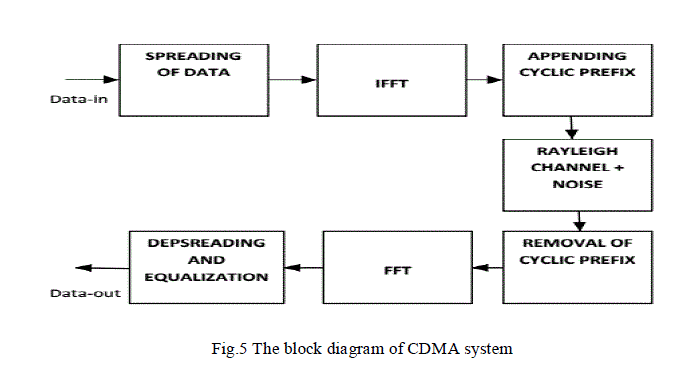 |
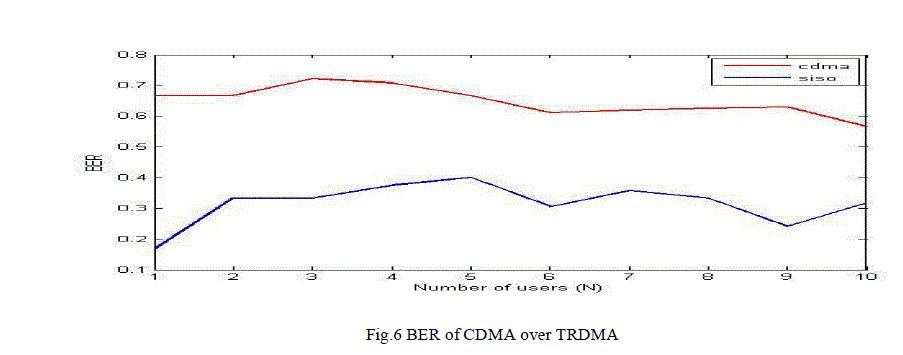 |
BPSK VS BFSK |
| In this section we consider the impact of modulation schemes on the effective SINR.Two digital modulation techniques were considered: Binary Phase Shift Keying (BPSK) and Binary Frequency Shift Keying (BFSK). BPSK uses two phases separated by 180° and so can be termed as 2-PSK. It modulates only 1 bit/symbol and is unsuitable for high data-rate applications. The simplest FSK is BFSK. BFSK uses a pair of discrete frequencies to transmit binary (0s and 1s) information. Fig.7 plots the Effective SINR obtained using BPSK and BFSK.One can see that over channels with additive white Gaussian noise BPSK shows slight improvement over BFSK .This is because BPSK is more bandwidth efficient than BFSK and hence results in lesser interference. |
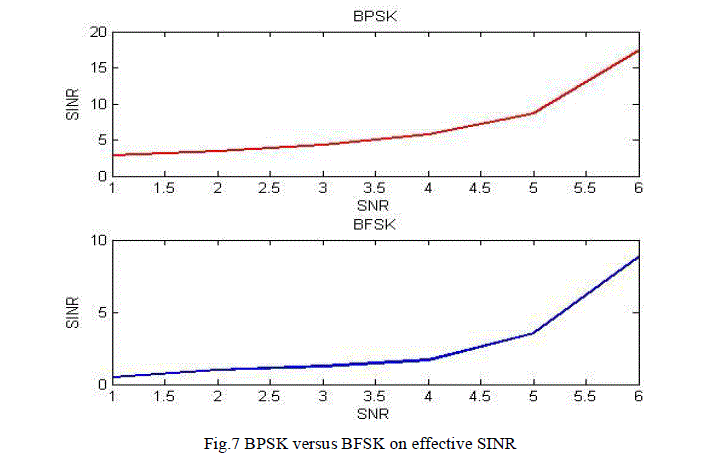 |
CONCLUSION |
| In this paper, we proposed a TRDMA scheme for the multi-user downlink network over multi-path channels. By utilizing the location-specific signatures that exist in the multi-path environment we develop both single antenna and multiple antenna system model. We simulated and evaluated a variety of performance metrics such as bit error rate, effective SINR and achievable sum rates. We also demonstrated the TRDMA’s improvement of bit error rate over CDMA over uncorrelated channels and the effective SINR obtained using BPSK and BFSK.Based on the nice properties obtained while simulation one can say that this can be used to transmit data to objects without knowing the correct location of the object since time-reversed signals follow the same path in the backward propagation. Thus TRDMA can be a promising candidate for future low complexity energy efficient wireless communications. |
ACKNOWLEDGEMENT |
| The authors wish to thank everyone who may be directly or indirectly involved in helping the completion of this work. |
References |
|